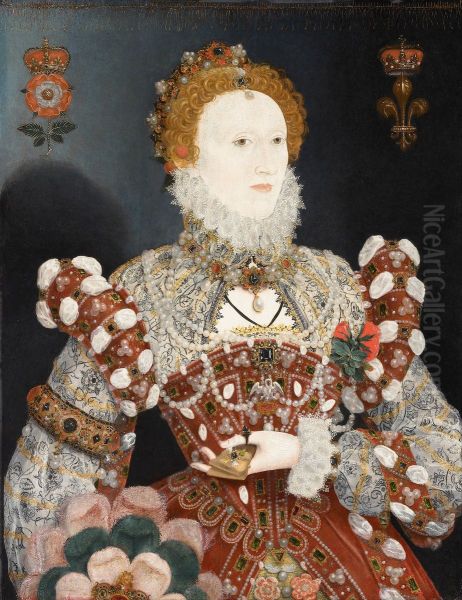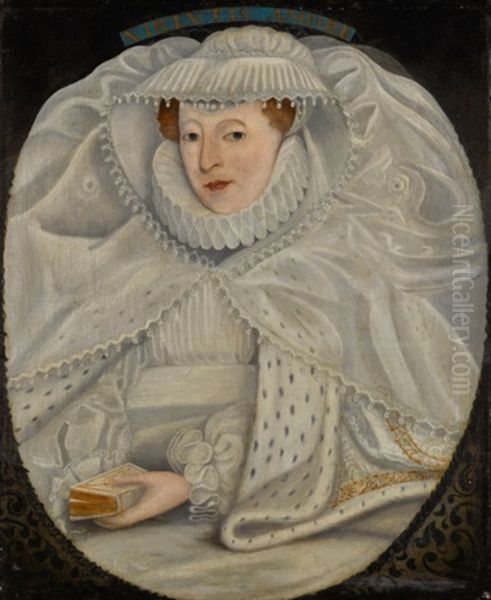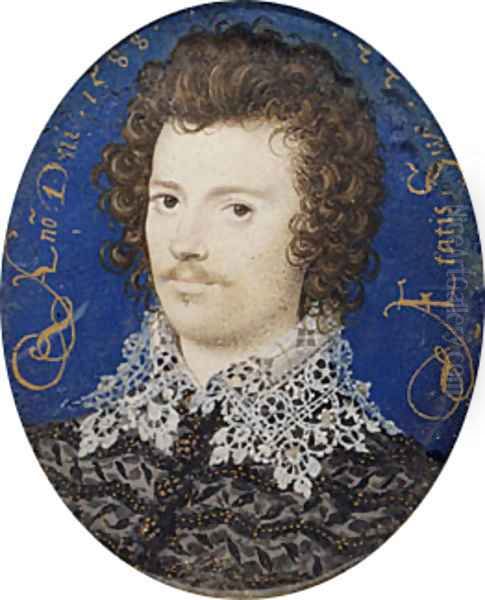Nicholas Hilliard (c. 1547–1619) stands as a towering figure in the landscape of English art, celebrated as the foremost miniaturist of the Elizabethan and early Jacobean eras. His delicate, jewel-like portraits captured the likenesses of monarchs, courtiers, and the elite, offering an intimate glimpse into the opulent world of the English Renaissance. Working primarily as a goldsmith and limner (a term for a painter of miniatures), Hilliard's artistry defined a uniquely English style of portraiture, characterized by its meticulous detail, linear precision, and psychological insight, all condensed into a remarkably small scale.
Early Life and Formative Influences
Born in Exeter, Devon, around 1547, Nicholas Hilliard was the son of Richard Hilliard, a devoutly Protestant goldsmith, and Laurence, daughter of John Wall, a London goldsmith. This familial background in goldsmithing was pivotal, instilling in the young Hilliard an appreciation for fine craftsmanship, intricate detail, and the handling of precious materials from an early age. The skills of a goldsmith—engraving, enameling, and delicate metalwork—would prove foundational to his later success as a miniaturist.
His early years coincided with a period of religious turmoil in England. It is believed that during the reign of the Catholic Queen Mary I, Richard Hilliard may have taken his family into exile for their Protestant beliefs. Some accounts suggest that Nicholas spent part of his youth in Geneva, Switzerland, a major center of the Protestant Reformation and a hub for humanist learning. This period, if it occurred, would have exposed him to continental European culture and languages, potentially including French, which would serve him well later in his career. By 1559, with the accession of the Protestant Queen Elizabeth I, the family was likely back in England.

Hilliard's formal artistic training began in earnest when, around 1562, he was apprenticed to Robert Brandon, a prominent goldsmith to Queen Elizabeth I and Chamberlain of the City of London. This apprenticeship, lasting approximately seven years, further honed his skills in metalwork and design. In 1569, Hilliard became a freeman of the Worshipful Company of Goldsmiths, a significant step that marked him as a qualified master of his craft. It was during this period that he also began to develop his distinct talent for miniature painting.
The Rise of a Royal Limner
The art of the portrait miniature was already established in England, with artists like Lucas Horenbout and Hans Holbein the Younger having created exquisite examples for the court of Henry VIII. Holbein, in particular, with his sharp characterization and flawless technique, became a profound influence on Hilliard. Hilliard himself acknowledged this debt, writing in his later treatise, A Treatise Concerning the Arte of Limning, that Holbein’s manner of limning he "ever imitated." Another notable predecessor at the English court was Levina Teerlinc, a Flemish miniaturist who served Henry VIII, Edward VI, Mary I, and Elizabeth I, bridging the gap between Holbein and Hilliard.
Hilliard’s talent did not go unnoticed for long. By the early 1570s, he had attracted the attention of Queen Elizabeth I. His earliest dated miniature of the Queen is from 1572. He was soon appointed as her official limner and goldsmith, a prestigious position that granted him unparalleled access to the monarch and her court. This royal patronage was crucial, providing him with a steady stream of commissions and solidifying his reputation as the leading miniaturist of his day. He was responsible not only for painting the Queen's likeness but also for designing and creating elaborate jeweled settings for these miniatures, as well as medals and royal seals, including the Second Great Seal of England for James I.
Artistic Style and Technique
Hilliard’s style is instantly recognizable. He worked primarily with opaque watercolors (gouache) on vellum (prepared animal skin), often stuck to a piece of card, typically a playing card, for support. His technique emphasized a bright, even light, deliberately avoiding strong shadows on the face, which he believed would mar the sitter's features. In his Treatise, he famously advised that limnings should be "best in plain lines without shadowing." This resulted in portraits that possess a certain flatness but are incredibly rich in linear detail, capturing the intricate patterns of lace, the gleam of jewels, and the texture of hair with astonishing precision.

His palette was often bright, utilizing vibrant blues, crimsons, and gold leaf to enhance the richness of the costumes and backgrounds. The backgrounds themselves were frequently a flat, brilliant azure, sometimes inscribed with gold lettering indicating the sitter's age, the date, or a personal motto. These inscriptions, along with symbolic imagery often incorporated into the portraits, added layers of meaning, reflecting the Elizabethan fascination with emblems and allegory.
Hilliard’s approach was deeply personal. Miniatures were intimate objects, often exchanged as tokens of love, loyalty, or friendship. They were designed to be held in the hand, worn as jewelry, or kept in ornate cases. This intimacy is reflected in the direct gaze of many of his sitters and the subtle psychological nuances he managed to convey despite the small scale and stylized conventions of the form. He sought to capture not just a physical likeness but also the "grace in countenance," the inner spirit of the individual.
Key Patrons and Notable Sitters
Queen Elizabeth I was, of course, Hilliard’s most important patron. He created numerous portraits of her throughout her reign, shaping her iconic image. These include the Pelican Portrait (c. 1575, Walker Art Gallery, Liverpool, though the full-scale oil is attributed to Hilliard, the miniature version is a key example of his work with her imagery) and the Phoenix Portrait (c. 1575, National Portrait Gallery, London, again, a motif he popularized in miniature). These portraits were laden with symbolism – the pelican representing self-sacrifice and the phoenix symbolizing rebirth and chastity – all carefully curated to project the Queen's power and mystique.
Beyond the Queen, Hilliard painted a veritable who's who of the Elizabethan and Jacobean courts. His sitters included powerful noblemen like Robert Dudley, Earl of Leicester; Sir Francis Drake, the famed seafarer; Sir Walter Raleigh; and George Clifford, Earl of Cumberland, famously depicted as the Queen's Champion. One of his most celebrated works is Young Man Among Roses (c. 1587, Victoria and Albert Museum, London), an enigmatic and romantic image believed to depict a courtier, possibly Robert Devereux, 2nd Earl of Essex, a favorite of the Queen. The languid pose, the intricate detail of the roses, and the melancholic air make it a quintessential example of Elizabethan courtly love imagery.
His Self-Portrait of 1577 (Victoria and Albert Museum) shows him as a confident young artist, aged 30, already established and aware of his own skill. He also painted James I and his family after the King's accession in 1603, though by this time, new artistic currents were beginning to emerge.
Travels and Continental Connections

In 1576, Hilliard traveled to France, possibly in the entourage of the Duke of Anjou (formerly Alençon), who was a suitor to Queen Elizabeth. He remained there until 1578 or 1579. This period abroad was significant, exposing him to the sophisticated art of the French Valois court. He would have encountered the work of French court painters like François Clouet and Jean Decourt, whose refined portraiture and elegant Mannerist style likely resonated with his own sensibilities.
During his time in France, Hilliard is known to have worked for members of the French aristocracy, including creating a portrait of Alphonse de Ducal. He also reportedly met the poet Pierre de Ronsard, who is said to have compared Hilliard favorably to the ancient Greek painter Apelles. This French sojourn undoubtedly broadened Hilliard's artistic horizons and reinforced his status as an artist of international caliber, even if his core style remained distinctly English and rooted in the Holbein tradition. He may also have encountered the work of Italian artists or their influence through French intermediaries, such as the School of Fontainebleau, known for its elongated figures and decorative elegance.
Contemporaries, Students, and Artistic Circle
Hilliard did not work in isolation. The London art scene, though smaller than Paris or Antwerp, was active. Besides the aforementioned Levina Teerlinc, other artists were active in England. Large-scale portraiture was dominated by figures such as Marcus Gheeraerts the Younger, Robert Peake the Elder, and John de Critz (who became Serjeant Painter to James I). These artists often worked in a style that, while detailed, was distinct from the intimate focus of Hilliard's miniatures. Occasionally, foreign artists like Federico Zuccaro would visit and work in England, bringing with them different stylistic approaches.
Hilliard’s most significant student and eventual rival was Isaac Oliver (c. 1565–1617). Oliver, of French Huguenot descent, initially trained under Hilliard and absorbed much of his master's technique. However, Oliver was more receptive to continental Baroque influences, particularly the use of chiaroscuro (light and shadow) to create a greater sense of volume and naturalism. As tastes began to shift in the early 17th century, Oliver's more modern style gained favor, particularly with Anne of Denmark, Queen consort of James I, and Prince Henry. Despite this emerging rivalry, the two artists dominated English miniature painting for decades.
Hilliard also trained other apprentices, including Rowland Lockey (c. 1565-1616), who is known for his copies of larger portraits, including those in the collection of Bess of Hardwick. Hilliard's son, Laurence Hilliard (c. 1582–1648), also became a miniaturist, continuing his father's workshop and style, though perhaps without the same spark of genius. The tradition of English miniature painting would continue to flourish after Hilliard and Oliver, with artists like Peter Oliver (Isaac's son) and later, the incomparable Samuel Cooper, who brought a new level of psychological depth and painterly realism to the art form.
Later Life, Financial Struggles, and Legacy
Despite his artistic success and royal patronage, Hilliard experienced persistent financial difficulties throughout his life. He invested unwisely in a gold-mining scheme in Scotland, which proved disastrous. Court payments were often slow and irregular, and he seems to have struggled to manage his finances effectively. In 1617, he was briefly imprisoned in Ludgate Prison for debt, a sad predicament for an artist of his stature.
Nicholas Hilliard died in London in early January 1619 and was buried in the parish of St Martin-in-the-Fields. His will mentions his son, Laurence, as his executor and heir to his artistic tools and unfinished works.
His Treatise Concerning the Arte of Limning (written around 1600 but not published until the 20th century) is an invaluable document. It provides insights into his techniques, artistic philosophy, and the practicalities of being a court artist. It is one of the very few surviving theoretical writings by an English artist of this period and offers a unique window into the world of Elizabethan art.
Hilliard's legacy is immense. He effectively established the character of English miniature painting for over a century. His works are not merely historical records but exquisite works of art in their own right, celebrated for their delicate beauty, intricate craftsmanship, and the intimate connection they offer to the personalities of the Elizabethan age. His influence extended through his students and followers, shaping the trajectory of this uniquely English art form.
Enduring Appeal and Collections
Today, Nicholas Hilliard's miniatures are treasured in major museum collections around the world. The Victoria and Albert Museum in London holds a significant collection, including the Young Man Among Roses and his 1577 Self-Portrait. The National Portrait Gallery, London, also has key works, including important portraits of Elizabeth I. Other institutions with notable Hilliard holdings include the British Museum, Windsor Castle (Royal Collection), the Walker Art Gallery in Liverpool, and the National Museum of Sweden. Penrhyn Castle in Wales is home to the full-scale Ermine Portrait of Elizabeth I, sometimes attributed to Hilliard or William Segar, another herald and portraitist of the era. The Abbot Hall Gallery in Kendal holds his portrait of George Clifford.
The enduring appeal of Hilliard's work lies in its combination of historical significance and aesthetic brilliance. These tiny, jewel-like objects transport us back to a vibrant and fascinating period, allowing us to come face-to-face with the men and women who shaped Elizabethan and Jacobean England. As an art historian, one cannot overstate his importance in defining a national artistic identity at a time when England was asserting itself on the world stage. He was, in essence, the visual poet of Elizabeth's "Golden Age."